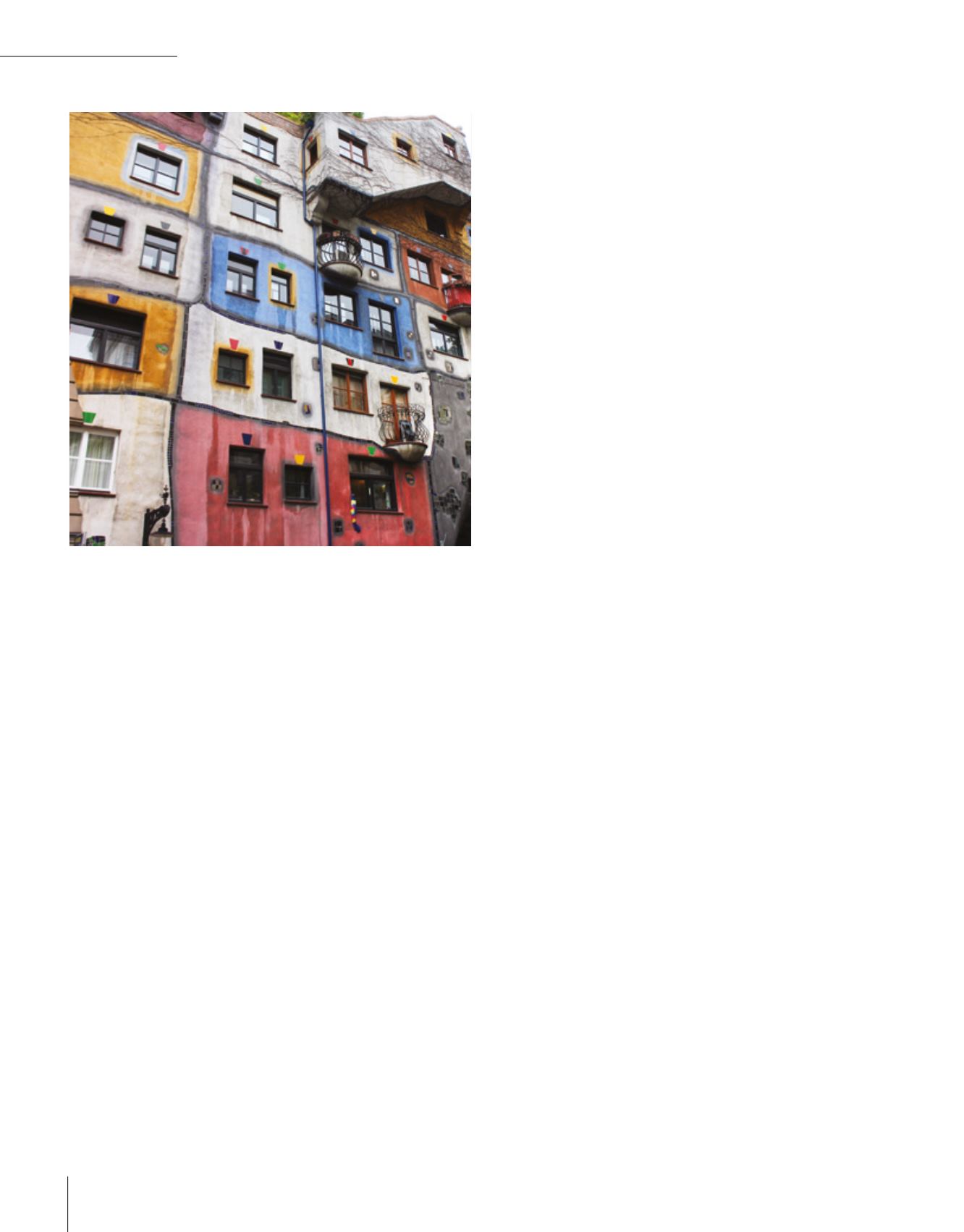
110
uzaktaki yakın
so far so close
olarak nitelendiriliyor.
Mimarın en öne çıkan
eseri ise Landstrasse’deki
Hundertwasserhaus. Hiçbir
yerinde düz öğe kullanılmamış
ve dış yüzeyi rengarenk
olan bina ağaçlarla bezeli
terasları ile Viyana’nın en çok
turist çeken noktalarından
biri. Bugün hala gündelik
yaşamın sürdüğü bina
aslında belediyenin
yaptırdığı ve düşük maliyetle
planlanan bir tür sosyal
konut. İçinde halen ikamet
edildiği için binayı ziyaret
etme şansınız yok, ancak
binanın hemen karşısında
yine Hundertwasser’in eseri
bir pasaj mevcut. Bodrum
kattaki tuvaleti es geçmeyin.
Hediyelik eşyalar için oldukça
zengin dükkanların olduğunu
belirtmeli. Hundertwasserhaus
yakınında bir de mimarın
eserlerini barındıran müze
mevcut. Mimarın Viyana’daki
diğer bir eseri ise Spittelau
semtinde yer alan katı atık
enerji santrali. İlgi çekici bacası
ve yine rengarenk gövdesi
ile şehrin birçok yerinden
rahatlıkla görülebiliyor ve enerji
santralinden daha çok çocuklar
için tasarlanmış bir masal
ev gibi duruyor. Mimariye
ilgisi olanlar için bir dipnot:
Spittelau’nun çok yakınında
dünyanın yaşayan mimari
starlarında Zaha Hadid’in
tasarladığı bir site de mevcut.
Yeri gelmişken belirtmeli.
Sayfalar tükendi anlatacaklarım
bitmedi. Viyana denince ilk
akla gelen saraylar, ihtişamlı
binalar, aristokrasi ve klasik
müzik olunca insan ister
istemez acaba bir yerden
sonra sıkıcı ve boğucu olabilir
mi gibi bir düşünceye kapılıyor,
haklısınız. Ama önümüz yaz,
Viyana yaz aylarında bir çiçek
gibi açılan, pozitif enerjisiyle
hayat verdiği valsin coşkusunu
hissettiren, cıvıl cıvıl, yaşayan
bir şehir. Her gezgin Viyana’da
kendi tercihlerine uygun
bir rota belirleyebilir. Tarih,
sanat, mimari, doğa, alışveriş,
eğlence... Ve bir de koca bir
“öpücük”. Daha ne olsun?
though it is a Central European
city, one can say that the
Viennese swim more than the
residents of Izmir or Istanbul.
There are many beaches along
the channel as well as many
pools scattered around the city.
You can enter these by paying a
moderate fee and spend a day by
the pool side. It should also be
emphasized that all facilities are
top notch.
You can make long walks along
the channel and the river located
to the north of the old city. There
is a large park that is almost
a forest which has been well
preserved here: Prater. There is
also a famous amusement park
and a historical Ferris wheel
known as Wiener Riesenrad
which is one of the symbols of
the city. It has been constructed
in 1896 by the English architect
Basset with thirty carriages
for the 50th anniversary of the
ascension to the throne of the
Emperor Franz Jozeph the 1st
and almost all of it has burned
down during the 2nd World War.
In 1947 it has restarted operation
with 15 carriages. This historical
Ferris wheel is built on a high
hill and do not miss watching
the panoramic view of the city
as its carriages rotate slowly.
The amusement park where
Riesenrad is located at is also
interesting. We don’t need to
state that it is attractive especially
for children but it also attracts the
adults with the beer gardens that
can be visited all seasons. You
can sip your beer even during
the cold winter days thanks to
the heating system while eating
tasty sausages at the giant beer
republic of Schweizerhaus built
in 1920 by Karl Kolarik who was
also a butcher. The Ernst Happel
Stadium which football fans will
remember as the place where
the Austria national team plays
its matches is located inside the
large park at Prater.
You can now walk slowly
along the channel if you have
completed your fun and eating
at Prater. Enjoy the dense forest
you will pass through on your
way down to the channel as well
as the clear air in the midst of
one of the largest metropolis of
Europe. Our next target is the
Hundertwasser House located
right across the amusement
park on the other bank of the
channel. The Viennese say that
if Barcelona has Gaudi, we
have Hundertwasser. The mad
artist has gained popularity
by turning ugly buildings into
beautiful ones. Hundertwasser
was 70 years old when he died
in 2001 and is known as an
original, madcap artist. The most
prominent work of the architect is
the Hundertwasserhaus located
at Landstrasse. The building is
one of the most touristic spots on
which no flat element has been
used and the colorful façade of
the building is surrounded by
terraces with trees. Today, the
building is actually a community
housing built by the municipality
and planned to be of low cost.
You cannot visit the building
where residents live, but a
passage which is another work
by Hundertwasser is located
right across. Do not forget to
see the toilet in the cellar. We
should also mention that there
are a lot of souvenir shops in the
vicinity. There is also a museum
near Hundertwasserhaus where
the works of the architect are
on display. Another work of the
architect in Vienna is the solid
waste energy central located
in the Spittelau district. It can
easily be seen from many parts
of the city with its interesting
chimney and colorful body and
resembles a fairy tale house for
children instead of an energy
central. A footnote for those
interested in architecture: there
is also a complex designed by
world famous living legends of
architecture Zaha Hadid close to
Spittelau. We should also note
this.
Pages are almost over but I have
still many things to tell. One can
think that Vienna will be boring
after a while since the first things
that come to mind are palaces,
grandiose buildings, aristocracy
and classical music. But summer
is coming and Vienna is actually
a very lively city in which you
can feel the joy of waltz and the
positive energy of a city that
opens up like wild flowers during
summer months. Every traveler
can prefer a route for themselves
based on their own preferences.
History, art, architecture, nature,
shopping, fun… And a huge
“kiss”. What more can there be?


